France


Crowds along the Champs Elysées celebrate the liberation of Paris.
French culture has been widely admired since the 13th century, when the other courts of Europe adopted its language, poetry and manners. Today it’s the food, the wine and the joie de vivre that many of us admire about the French. In a nation where dining is an art form, and where the arts are for all to enjoy, the many aspects of gracious living fall into fascinating perspective. Politics are important, but so is lunch. And for the average visitor to France, figuring out the lunch menu could well be easier than understanding the many departments, districts, cantons and communes of French government.
Map of France
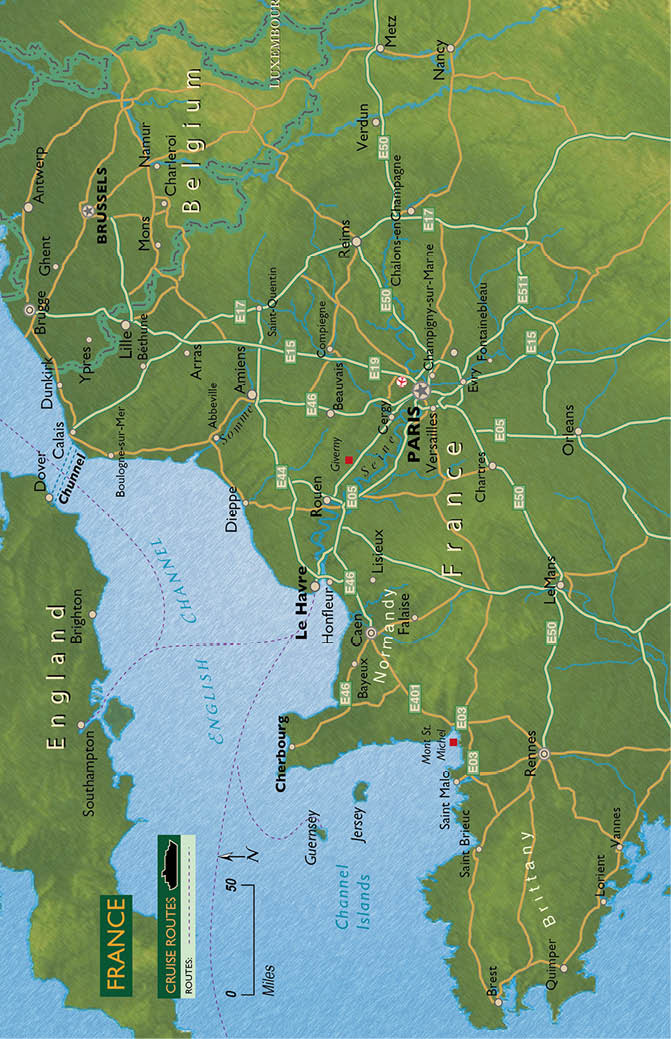
France has had a centralized administration since the Revolution of 1789, yet each region has retained its own distinct character. This diversity harks back to the Middle Ages, when provinces were ruled by dukes and counts, and feudal power was held by nobles, guilds and the clergy.
France was first settled by Greek and Phoenician traders, then conquered by Julius Caesar in 58 BC. For five centuries Gaul, as the Romans called it, was under Rome’s rule. Then, in 486 AD, the Franks – a Germanic tribe – routed the last Roman emperor of Gaul and the region soon lay in ruins. The only remnant of Roman civilization was the church, which also faced ruination when Saracens invaded in the 8th century.
The Carolingian dynasty, led by Pepin the Short, rescued the region, and his son Charlemagne (Charles the Great) became a legendary figure. Crowned Emperor of the West on Christmas Day in the year 800, Charlemagne was immortalized in medieval poems as the champion of Christendom. A great leader and administrator, he ushered in an intellectual renaissance and promoted the rebirth of learning and the arts.
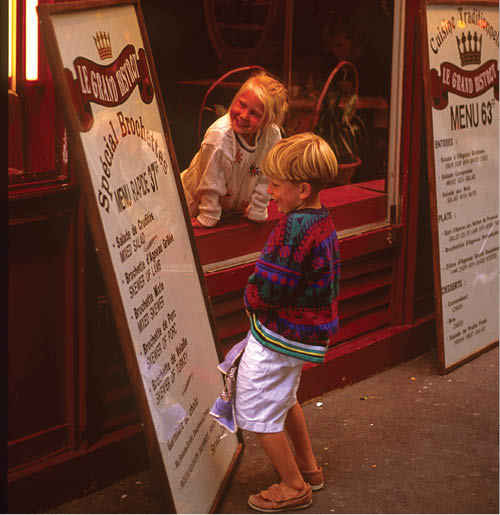
Studying the lunch menu in Paris’s Latin Quarter.
A thousand years later Napoleon Bonaparte drew on Charlemagne’s example when forging his empire, and his liberal reforms lay the groundwork for modern-day France. The nation’s most recent military hero was Charles de Gaulle, who organized the Free French forces during World War II and became the first president of France’s Fifth Republic. General de Gaulle is regarded by the French as one of their greatest citizens of all time, while icons of French culture include the writer Victor Hugo, the impressionist painter Claude Monet and the cabaret singer Edith Piaf. July 14 is Bastille Day, a national holiday celebrated with parades and fireworks. (For information on the French Revolution, see History section in Part I.)
The population of France is 65 million, and Roman Catholicism is the major religion. Paris is the capital and the country is governed by an elected president, who appoints a premier responsible to the National Assembly. France is an industrial nation and major economic power, yet more than half of its land area is still used for agriculture. Tourism is also a major industry, with France receiving more international tourists than any other country in the world. The official language is, naturally, French, although some English is spoken in most tourist areas. When entering a shop, be sure to greet the proprietor before you start browsing, or you will be considered rude. It’s also polite to say goodbye when leaving. Useful words in French are: bonjour (hello), au revoir (goodbye) and, when asking for assistance, pardonez mois (pardon me), parlez vous Anglais? (do you speak English?) and merci (thank you). When ordering in a restaurant, begin with s’il vous plait (if you please) and ask for your cheque when finished.
France uses the 24-hour clock: 0:00 to 11:59 is AM and 12:00 to 23:59 is PM (12:00 = noon, 24:00 = midnight). France’s country code is 33 when telephoning internationally. The unit of currency is the euro.
The two main French ports of call on a Northern Europe cruise are Cherbourg and Le Havre. These Normandy ports provide access to the D-Day landing beaches and historic towns such as Honfleur and Rouen. Le Havre also serves as a port of access to Paris, which is a three-hour drive or a two-hour train ride each way.
Map of La Havre
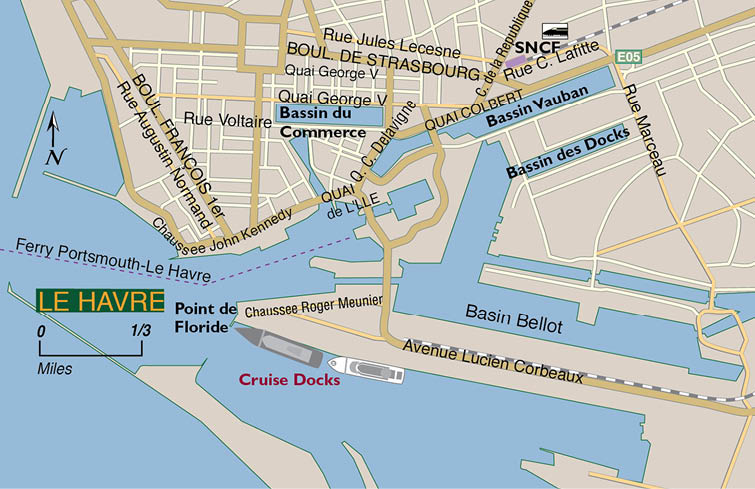
Le Havre is a large commercial port at the mouth of the river Seine. Destroyed during World War II, the city (pop. 185,000) was rebuilt in the modernist style, for which it has been classified a World Heritage Site. The cruise ships dock at Florida Pier where a Cruise Welcome Centre provides a full range of services and visitor information. Car rentals are available for self-drive tours of the Normandy countryside or you can hire a taxi at the cruise dock for a tour of the area. Walking from the port into town is restricted and the cruise lines usually offer a shuttle bus between the port and the train station, where there are regular departures for Paris (Gare Saint Lazare). Most cruise lines also offer a coach shuttle to Paris, dropping passengers off at a central location with pick-ups in the same spot four or five hours later for the return trip to Le Havre. ATMs and currency exchange kiosks are plentiful in Le Havre and Paris.
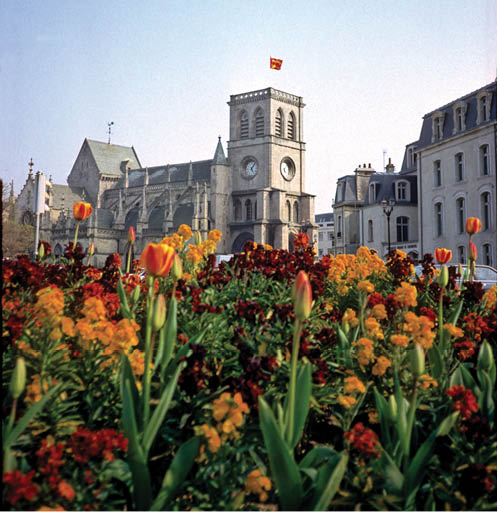
Cherbourg’s Cathedral
Cherbourg (pop. 42,000) is a naval base and industrial seaport overlooking the English Channel. Its new cruise terminal (Gare Maritime Transatlantique) opened in 2006 next to the Cité de la Mer, a maritime museum, both of which are housed in the refurbished remains of a 1930s Art Deco ship terminal and train station complex where great ocean liners of the past once called. The cruise terminal is a short walk to the town centre of cobblestoned streets near the boat harbour. The train station is further afield on Avenue Francois-Miller; the train ride from Cherbourg to Paris-Saint-Lazare is three hours. Cars can be rented in town (reserve ahead online) and taxis are plentiful.
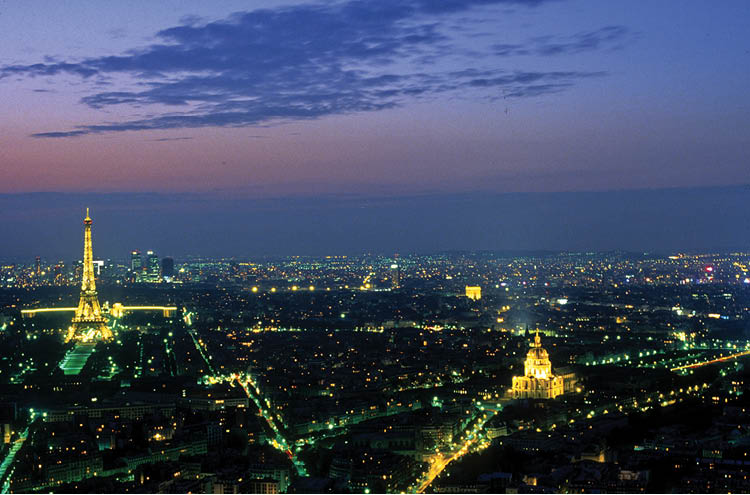
The Paris skyline at night.
Paris, the City of Light, is one of the world’s most beautiful cities. Stately tree-lined avenues lead to monumental squares from which winding medieval streets fan out in all directions. At night, a sparkling blanket of lights adorns the city, especially when viewed from atop Montmartre Hill, and the River Seine becomes a shimmering ribbon that winds through the heart of the city. Once a grubby town of crowded, filthy streets, Paris was remodelled in the mid-1800s when many of its narrow streets were torn down to make way for wide avenues lined with handsome neo-classical buildings, their heights limited by building codes to create a unified roofline. Street lighting was also introduced, enhancing the riverside walks and tree-lined boulevards.
With a population of 10 million, Paris is France’s economic engine and one of the world’s leading business centres. The skyscrapers of the city’s business district are strategically located apart from the historic core, where the elegant 19th-century atmosphere has been preserved, making the city centre an inviting place for walking and soaking up the sights and sounds.
